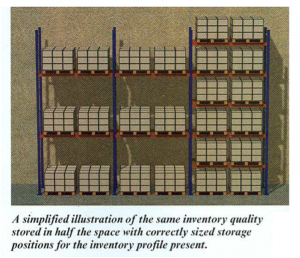
Distribution center storage configuration; not a topic that immediately comes to mind when you seek to elevate your distribution operations to best-in-class levels. Productivity, order cycle time, accuracy, cross dock percentage and even environmental friendliness usually make the top of the ‘best-in-class’ characteristics of a distribution operation—and well they should. However, with the current pressures across our “Covid-recovering” supply chains, industrial real estate space is at a greater premium than at any time in recent memory. Since the majority of space in most distribution centers is dedicated to storage, optimizing vertical storage in a facility will have the greatest impact on space requirements. Any economies provided by storage space efficiency returns benefits through lease cost avoidance in the worst case, and, in the best case, the ability to continue to service all customer demands without additional real estate investment.
The best example to begin with is usually the simplest, and in distribution that means talking about a pallet. The most common rack configuration, single deep selective racking, serves to hold full unit loads of product stored on a unit load carrier, which we’ll assume is a pallet (apologies to slip sheets and alternative unit load devices). The rack openings are sized generally to hold a full pallet worth of product, let’s say five feet high, so the storage position openings would be about five and a half feet high to allow for movement of the pallet in and out of the position. However, most distribution operations have some measure of product in less than pallet quantities. If only full pallet positions were available, many slots would be dramatically under utilized, resulting in a lower overall storage capacity. Adding beams within the existing rack structure to create the appropriate number of partial pallet locations will increase the overall density of the storage system.
 The cautions associated with right sizing partial pallet storage are few but very important. If all the partial pallets in stock started life as full pallets of product and were depleted over an extended period of time, they would need to be put away as two partial pallets to achieve a utilization increase over time. In this case, one of the two half-pallet positions becomes available for other product in half the time it would require the depletion of a full pallet. Hopefully this example also makes clear that analysis of the appropriate number of partial pallet positions needs to review the operation’s use of storage over time. Working with one single snapshot may cause the installation of too many partial positions, leaving the operation with a shortage of full positions at another time of year when they may be required.
The cautions associated with right sizing partial pallet storage are few but very important. If all the partial pallets in stock started life as full pallets of product and were depleted over an extended period of time, they would need to be put away as two partial pallets to achieve a utilization increase over time. In this case, one of the two half-pallet positions becomes available for other product in half the time it would require the depletion of a full pallet. Hopefully this example also makes clear that analysis of the appropriate number of partial pallet positions needs to review the operation’s use of storage over time. Working with one single snapshot may cause the installation of too many partial positions, leaving the operation with a shortage of full positions at another time of year when they may be required.
Right sizing locations does not only apply to making pallet positions smaller, nor only apply to product stored on pallets. For large quantities of storage, such as items that have over a half dozen pallets in stock consistently, storage strategies or equipment configured for larger quantities of a single item will yield density increases over single deep selective racking. For product that is stable enough to stack upon itself, deep lane bulk storage with no racking required may be optimal. For product unable to stack safely, racking options such as double deep selective rack, push back rack and drive in racking all offer significant density increases for the operation whose storage requirements make deeper rack configurations suitable. The same analysis over time of storage demands that serves to determine if partial pallet positions are appropriate can determine if and how much deep storage could best service the operational storage needs.
Given the exceptionally high demand for industrial space at this very moment, right sizing storage equipment within your facility can return more value to your operation than ever before. Mining this value requires caution that you right-size the storage equipment and not just simply ‘downsize’ it. With optimally sized pick and storage location sizes, an operation increases fixed-asset utilization and reduces variable operating costs, moving closer to best in class on both fronts and making better use of a supply chain commodity with increasing scarcity—space.
—Bryan Jensen, St. Onge Company